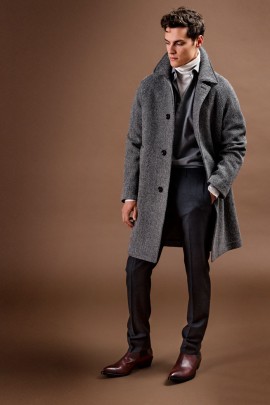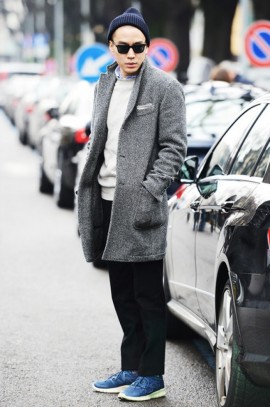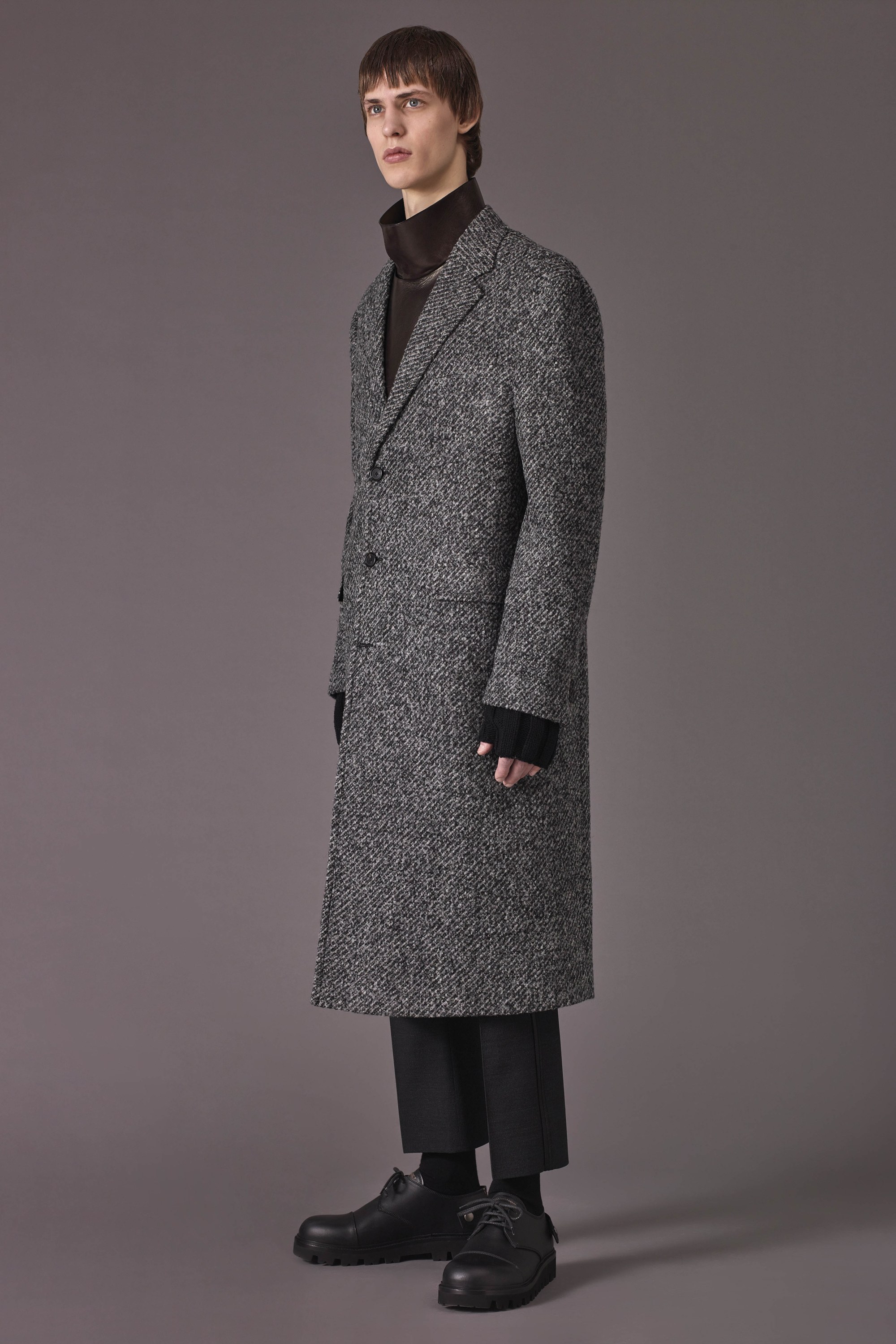C COME COAT
A sinistra, scatto di Federico Miletto per The Men Issue, Styling Giovanni de Ruvo. A destra, scatto di streetstyle (fonte: http://blog.trashness.com/)
L’alfabeto della moda oggi chiama in causa la lettera C: Coat, in italiano Cappotto.
Capo di derivazione contadina o militare, il cappotto è andato col tempo a sostituire i mantelli e le pellicce dell’antichità, diventando non solo un alleato indispensabile contro il freddo invernale, ma soprattutto un simbolo di appartenenza ad un determinato ceto sociale.
Infatti, ricordo che, passeggiando da bambino per le vie del corso della città con i miei genitori, specialmente durante le domeniche invernali o durante le festività natalizie, vedevo famiglie intere passeggiare, imbellettate, con capelli e barbe perfette, scarpe lucide e spazzolate, dove il capo famiglia primeggiava su tutti per le fattezze e l’importanza statuaria del proprio cappotto. Spalle larghe, materiale spesso, dalla caduta verso il basso rigida e impeccabile, quasi regale: il passeggiare si trasformava in una gara a chi, fra tutti gli uomini, avesse il capospalla più bello; un pavoneggiarsi, dove il premio finale, ai miei occhi, era quello di far parte della famiglia più benestante ed importante della città.
Anche nei film il cappotto era portato dall’attore più bello, dal protagonista, seguito puntualmente dal suo sottoposto, o maggiordomo, che in chiaro atto di servilismo lo aiutava ad indossarlo prima di uscire.
Esempio lampante della sua importanza simbolica lo abbiamo nel film Il Cappotto, tratto dal racconto di Nikolaj Gogol, ed interpretato da Renato Rascel, dove si percepisce quanto questo capo di abbigliamento sia l’oggetto del desiderio di un impiegato comunale che deve ottenerlo a tutti i costi, per sentirsi parte integrante di una società che altrimenti non lo considera.
In commercio lo si trova realizzato in panno di lana, in cachemire, monopetto o doppiopetto, di varie lunghezze, con la manica Raglan e con spalmature che lo rendono impermeabile; ne esistono davvero in svariati modelli e materiali. Un fedele alleato ed un pezzo immancabile nell’armadio di un uomo, ed ormai non più solo per i mesi freddi.
La moda, oggi, lo ha sdrammatizzato, dandone una nuova visione: accanto al cappotto formale, “divisa”, insieme all’abito sartoriale, dell’uomo di potere, è passato ad essere capo modaiolo, creato in varie fogge e colori, sfoderato, stampato, abbinato a felpe con cappuccio, e sovrapposto a giubbotti in denim, per la stagione invernale, tanto come per quella primaverile ed estiva.
Nello scatto realizzato per The Men Issue da Federico Miletto, il cappotto (Fall/Winter 17/18, Paltò), realizzato in panno di lana spigata con manica raglan, è abbinato ad una camicia indossata su un dolcevita e a dei pantaloni, tutti sulla scala cromatica dei grigi, con dei boots in pelle, per un’allure modaiola ma sempre classicheggiante; in quello a fianco invece abbiamo uno scatto di street style, che ci offre un’idea di come un cappotto simile possa essere indossato, in modo più libero e casual, nella vita “reale”. Nella gallery, invece, vi offriamo una carrellata di uscite di sfilata della stagione f/w 17/18 – con alcune anticipazioni dalla prossima s/s – per avere uno spaccato sulla visione dei maggiori designer. Giovanni de Ruvo
The Fashion Alphabet today is about C: C for Coat. A garment with country and military origins, the coat replaced during the decades cloaks and furs of antiquity, becoming not only an essential helper against winter cold, but also a symbol of social identity. Infact I remember when I was I child, walking down the streets of the city center with my parents, especially during winter sundays or Christmas holidays, I met entire families walking, with perfect hair and beards, polished shoes, where the head of the household stood out for his look and the statuesque importance of his coat. Wide shoulders, heavy fabric, with rigid and flawless drop, almost regal: the walk turned into a competition in who, among all the men, had the most beautiful coat; a showing off, where the final prize, to me, was the belonging to the wealthiest and most eminent family of the city. In movies the ciat was worn by the most handsome actor, the protagonist, promptly followed by his subordinate, or butler, that in clear servility helped him to wear it before going out. A glaring example of its symbolic importance is the movie Il Cappotto (The Coat), from the story by Nikolaj Gogol, and interpreted by Renato Rascel, where this garment becomes the object of desire for a municipal employee that wants to have it no matter what, to feel part of a society that otherwise doesn’t take care of him. We can find it in shops made of wool, cachemire, single or double breasted, with raglan sleeve and waterproof shells; there are several shapes and materials available. A loyal allied and fundamental piece in a man’s wardrobe, and not only for the cold season by now. Fashion, today, has downplayed it, giving a new vision: alongside the formal coat, “uniform”, with the tailored suit, of the powerful man, there’s a fashionable garment, made in different shapes and colours, unlined, printed, matched with hooded sweatshirts or denim jackets, for winter as well as for spring or summer. In the picture by Federico Miletto for The Men Issue, the coat (fw 17/18, Paltò), made of herringbone wool with raglan sleeve, is matched with a shirt worn over a turtleneck and with a paira of trousers, all in shades of grey, with leather boots, for a fashionable but classical allure; in the other one we have an example of street style, that shows us how a similar coat can be worn, in a more free and casual way, in “real” life. In the gallery, instead, we offer an overview of fw 17/18 fashion shows – with some previews of ss 18 – to have a taste of greatest designers’ concept. Giovanni de Ruvo








